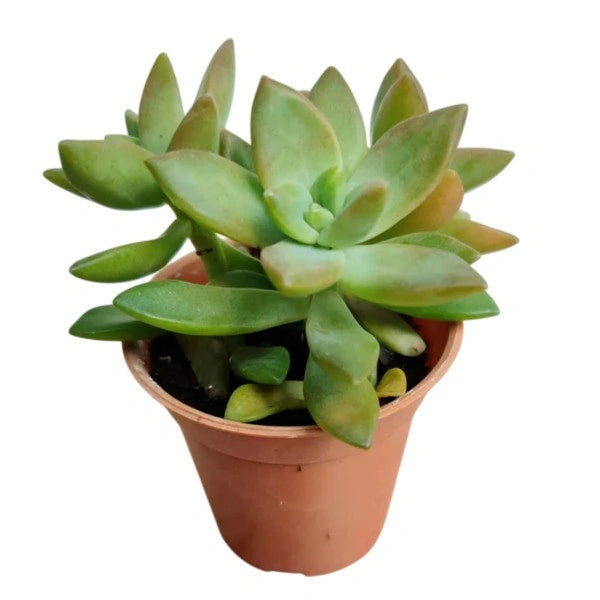
Sedum Adolphi Golden
Selling size: Single plant | 2.5″ Pot Included | Secure Packing
Golden Sedum, also known as Sedum Adolphi Golden. This is a fantastic succulent known for its vibrant lime green to golden yellow leaves, often with reddish or orange tips when exposed to bright sun.
Here's a comprehensive care guide for Sedum Adolphi Golden:
Bright, direct sunlight is essential for vibrant color. This is the most crucial factor for Sedum Adolphi Golden to display its beautiful golden and coppery hues. Without enough light, it can become leggy (stretched out) and its colors will be duller, more greenish.
Outdoor: In India's climate, aim for a spot that gets at least 6 hours of morning direct sunlight. In areas with very intense afternoon sun, some afternoon shade can be beneficial to prevent sunburn, especially during the hottest months.
Indoor: Place it in your brightest window, preferably a south-facing one. If natural light is limited, a grow light can help maintain its compact shape and vibrant coloration.
2. Watering:
"Soak and Dry" Method: This is key for succulents. Water thoroughly until water drains from the bottom of the pot. Then, allow the soil to dry out completely before watering again.
Frequency: In the hotter Indian climate, especially during the growing season (spring and summer), you might need to water more frequently than in cooler climates, perhaps every 1-2 weeks. During the cooler, dormant months (fall and winter), significantly reduce watering, sometimes to once a month or even less if the soil remains damp.
Check the Soil: Always check the soil moisture before watering. You can stick your finger about an inch or two into the soil. If it feels dry, it's time to water. The leaves might also show slight wrinkling when thirsty, but don't wait for extreme shriveling.
Avoid water on leaves: Try to water the soil directly to prevent water from sitting on the leaves, which can lead to rot, especially in humid conditions.
3. Soil:
Excellent Drainage is Non-Negotiable: Golden Sedum is highly susceptible to root rot if it sits in waterlogged soil.
Cactus and Succulent Mix: Use a commercial cactus and succulent potting mix.
Amendments: To improve drainage further, you can amend your potting mix with coarse sand, perlite, or pumice. A common ratio is 50-70% inorganic material (sand, perlite, pumice) to 30-50% potting mix.
Lean Nutrients: They prefer low-nutrient soil.
4. Potting:
Drainage Holes: Always use pots with drainage holes.
Material: Terracotta or unglazed clay pots are excellent choices as they allow for better airflow and moisture evaporation, reducing the risk of rot.
5. Temperature Humidity (Relevant to India):
Warm Temperatures: Golden Sedum thrives in warm conditions.
Hardiness: It's generally hardy in USDA Zones 9-11 (tolerating temperatures down to about 20-40°F / -6.7-4.4°C).
Frost Protection: While it can handle some cooler temperatures, protect it from any frost or near-freezing conditions. If temperatures drop significantly, bring potted plants indoors.
Humidity: While succulents generally prefer low humidity, Golden Sedum can tolerate average indoor humidity. In very humid monsoon seasons, ensure good air circulation to prevent fungal issues.
6. Fertilizing:
Minimal Needs: Golden Sedum doesn't require heavy fertilization.
During Growing Season: If you choose to fertilize, use a highly diluted (half-strength or quarter-strength) liquid fertilizer specifically formulated for succulents or cacti. Apply once a month or once every two months during the active growing season (spring and summer).
Avoid in Dormancy: Do not fertilize during the cooler, dormant months.
7. Propagation:
Very Easy: Golden Sedum is incredibly easy to propagate from both stem and leaf cuttings.
Leaf Cuttings: Gently twist a healthy, plump leaf from the stem. Allow the leaf to "callous over" for a few days (this means the cut end will dry and seal). Then, lay the calloused leaf on well-draining soil. Lightly mist the soil when it's completely dry. Roots and a tiny new rosette will eventually form at the base of the leaf. The mother leaf will eventually shrivel and fall off.
Stem Cuttings: Use a sharp, sterile knife or scissors to cut a stem section. Allow the cut end to callous over for a few days. Then, insert the calloused cutting into well-draining soil. Water sparingly until roots develop.
Sunburn: Too much intense, unacclimated direct sun can cause brown or bleached spots on the leaves. Gradually introduce the plant to stronger light.
Pests: Generally resistant, but occasionally mealybugs or aphids can be an issue. Inspect your plant regularly. Treat with rubbing alcohol on a cotton swab for small infestations or an appropriate insecticidal soap.
Leaf Yellowing/Drooping: Can indicate either overwatering (root rot) or underwatering. Check the soil moisture carefully.
With proper care, your Golden Sedum will be a vibrant and low-maintenance addition to your plant collection!

